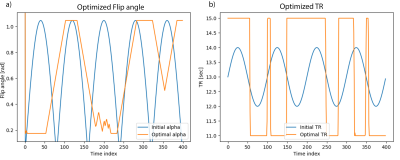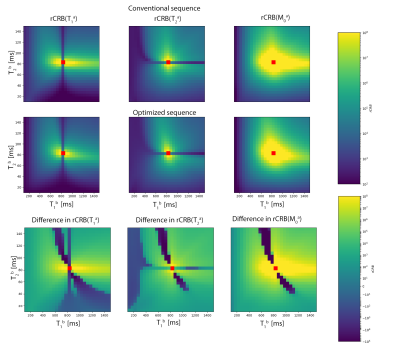David Heesterbeek1,2, Frans Vos1,3, Martin van Gijzen2, and Martijn Nagtegaal1
1Department of Imaging Physics, Delft University of Technology, Delft, Netherlands, 2Department of Numerical Analysis, Delft University of Technology, Delft, Netherlands, 3Department of Radiology and Nuclear Medicine, Erasmus MC, Rotterdam, Netherlands
1Department of Imaging Physics, Delft University of Technology, Delft, Netherlands, 2Department of Numerical Analysis, Delft University of Technology, Delft, Netherlands, 3Department of Radiology and Nuclear Medicine, Erasmus MC, Rotterdam, Netherlands
Multi-component MRF can provide time-efficient myelin water
fraction or partial volume estimations. By calculating and optimizing the
Cramér-Rao bound for MC-MRF we obtain new insight into sequence efficiency and
find optimal acquisition patterns.

Figure 3: a) FA and b) TR sequences at initiation and after optimisation for multi-component MRF. Optimisation was performed for tissue parameters {$$$T_{1}^{a}$$$, $$$T_{2}^{a}$$$, $$$M_{0}^{a}$$$} = {700ms, 60ms, 0.3} and {$$$T_{1}^{b}$$$, $$$T_{2}^{b}$$$, $$$M_{0}^{b}$$$} = {1100ms, 102ms, 0.3} with the constraints mentioned in the Methods section. Different initialisation of the optimisation problem returned the same result.

Figure 5: Relative CRB values were calculated using the multi-component Fisher matrix for a conventional MRF sequence (row 1) and an optimised sequence (row 2). The difference is shown in row 3 by subtracting the second row from the first. The rCRB is defined as $$$\text{rCRB} = \frac{\text{CRB}}{\sigma^2 \theta^2}$$$ where θ represents T1a, T2a or M0a. Tissue parameters for one tissue (superscript a) were fixed at T1a = 800 ms, T2a = 80 ms, while T1b and T2b for the second tissue (superscript b) vary. In the centre red dot the 2 tissues are exactly the same, resulting in a singularity.
